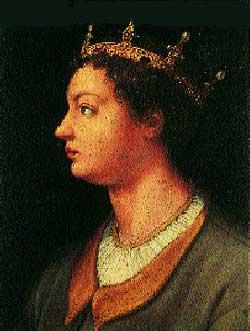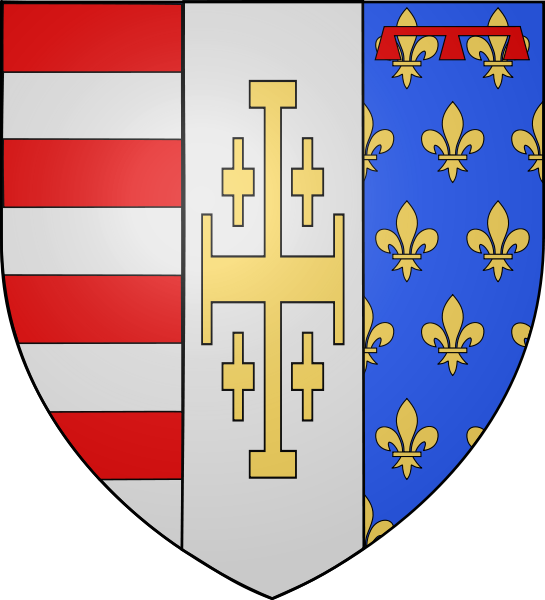<Back to Index>
- Biochemist Hans Karl August Simon von Euler - Chelpin, 1873
- Painter Adam Christiaensz Pijnacker, 1622
- King of Naples Ladislaus the Magnanimous, 1377
PAGE SPONSOR


Ladislaus the Magnanimous (Italian: Ladislao il Magnanimo di Napoli; Hungarian: Nápolyi László; 15 February 1377 – 6 August 1414) was King of Naples and titular King of Jerusalem and Sicily, titular Count of Provence and Forcalquier (1386 – 1414), and titular King of Hungary and Dalmatia (1390 – 1414). He was the last male of the senior Angevin line.
He
was named in honor to the King Saint Ladislaus I of Hungary, who was highly
venerated by the Angevin Kings Charles I of Hungary and Louis I of Hungary,
considered the model of the perfect King, Knight, and
Christian man in Central Europe during that time. Ladislaus of
Naples became a skilled political and military leader,
protector and controller of the Papacy of Innocent VII,
however he earned a bad reputation concerning his
personal life. He
profited from disorder throughout Italy to greatly
expand his kingdom
and his power, appropriating much of the Papal States to his
own use, also he murdered many of his enemies.
He was born in Naples, the son of Charles III and Margaret of Durazzo. He spent his early life with his family in the royal court of Naples, and in 1381 he was created Duke of Calabria and heir by Charles III.
He became the King of Naples at the age of nine (1386) under his mother's regency. At the time the kingdom saw a rebellion of the barons (fomented by Pope Urban VI), and there was a risk of a French invasion, since in 1385 the pope had assigned the throne to Louis II of Anjou, then head of the junior Angevin line, who contested the throne. Urban VI refused to recognize Ladislaus, and in 1387 called a crusade against him. Margaret and his son at the time controlled not much more than Naples and its neighborhood. After a turmoil broke out in the city, they fled to the fortress of Gaeta, while Otto of Brunswick, husband of Joan I, conquered Naples at the head of an Angevine army.
In 1389 the new pope Boniface IX recognized Ladislaus as King of Naples, although he forbade him to unite it with his family lands in Germany and Italy. In the following year he was poisoned by the archbishop of Arles: although he escaped, he subsequently suffered of stuttering and was forced to repeated periods of rest. Also in 1390, Louis II entered Naples. A war lasting nine years between him and Ladislaus followed, in which the latter was soon able to limit Louis' power at Naples and the Terra d'Otranto. Thanks to the support of several powerful barons of the Kingdom, including Raimondo Del Balzo Orsini, in 1399, while Louis was fighting against the count of Lecce, Ladislaus was able to re-enter Naples. The Angevins then decided to return to Provence. He spent the year 1400 subduing Onorato Caetani, count of Fondi, and the last rebellions in Abruzzo and Apulia.
In
1401 Ladislaus married to Mary of Lusignan,
daughter of the King of Cyprus. She arrived in Naples
in 1402. In the
same period, Ladislaus shortly tried to restore the
Angevine rule in
Hungary, where part of the nobles were against King Sigismund, and whose crown he had been
claimant to from 1390, together with Dalmatia. His
father, Charles III of Naples, grew up in Hungary
governing the region of Croatia and Dalmatia as Duke,
and eventually became king as Charles
II of Hungary.
Ladislaus
ordered the painting of a cycle of Saint Ladislaus'
legend in
the church Santa Maria dell'Incoronata in Naples
between 1403 and 1414.
There the Hungarian King is depicted receiving the
royal crown, also
fighting against the pagans, and receiving the crown
of Croatia
(actually the cult to Saint Ladislaus, and other
Hungarian Kings was
already present in Naples and other Italian regions
since the second
half of the 13th century, thanks to Mary of Hungary, Queen of Naples, who
transplanted them to his new home when became Charles II of Naples'
wife.) Considering
himself
as a descendant of the Holy Kings of Hungary,
Ladislaus tried
in many times to obtain the crown of Hungary, also
being crowned
illegitimately and bearing by his own will the title
of Duke of
Slavonia. He first negotiated a peace with the Republic of Venice in
exchange of the island of Corfu. He thus obtained
free passage in the Adriatic Sea and, with the partial
support of the Pope, landed at Zadar on
19 July 1403. However, Ladislaus remained inactive,
and returned to
Apulia; his authority in Dalmatia remained restricted
to Zadar and few
other lands. The following year, after the death of
Boniface IX, he
intervened in Rome in support of the Colonna family, two
days after the election of the new pope, Innocent VII.
Ladislaus endeavored to consolidate the royal power at the expense of the baronial, and brought about the murder of several members of the Sanseverino family for frustrating his ends. In 1405, he went again to Rome: when some nobles offered him the lordship of the city, the pope replied deposing him as king (18 June 1406). In the meantime, Raimondo Del Balzo Orsini had rebelled under request by the pope, but died soon afterwards in January 1406. His wife, Mary of Enghien, continued the rebellion and successfully defended Taranto in that year's spring against a two month long siege by Ladislaus. She did not surrender even after the king and the pope signed a treaty of peace in July, by which Ladislaus became the protector of the Papal States. He moved to Taranto again early in 1407, this time with diplomatic intentions. Since his first wife had died in 1404, Ladislaus solved the matter of Taranto by marrying to Mary of Enghien on 23 April 1407.
In 1407, trying to taking advantage of the feebler personality of the new pope, Gregory XII, Ladislaus invaded the Papal States and conquered Ascoli Piceno and Fermo. In 1408, he besieged Ostia to prevent a success of the French party in the schism between Gregory XII and Antipope Benedict XIII. After a short siege, he captured the city by bribing the Papal commander, Paolo Orsini, and entered Rome on 25 April. Later, Perugia also fell into his hands.
In 1409 Ladislaus eventually sold his rights to the kingdom of Dalmatia to the Republic of Venice for 100,000 ducats. This was part of his attempts to gain allies in the upcoming war against Florence, caused by his expansion in central Italy and his alliance with Paolo Guinigi, lord of Lucca, a traditional enemy of the Florentines. Ladislaus invaded Tuscany, capturing Cortona and Elba Island from Gherardo Appiani. The condottiero Braccio da Montone, hired by Florence, defeated his army, and Ladislaus was forced to retreat. However, he had not abandoned his aims to northern Italy, also taking advantage of the presence of Pope Gregory XII in Gaeta.
Fearing his aims, the Republics of Siena and Florence and the powerful cardinal Baldassarre Cossa allied against him. Antipope Alexander V excommunicated him, calling Louis II of Anjou to Italy to conquer Naples; the count of Provence arrived in Italy in late July 1409 with 1,500 cavalry and was invested with the Neapolitan crown. The league's troops, under Muzio Attendolo, Braccio da Montone and other condottieri, invaded the Papal lands under Ladislaus' control and moved to Rome; Orsini, left by Ladislaus to protect the city, switched to them with 2,000 men. However, the allies were only able to capture the Vatican and the quarter of Trastevere. Cossa and Louis abandoned the siege to their condottieri, and moved to northern Italy and Provence in search of further support.
Ladislaus took advantage of an anti - French revolt in Genoa to gain the support of that city (1410). Rome fell on 2 January, and the allies did not score any other notable results. On 16 or 17 May May, Louis' fleet, carrying new troops from Provence, was intercepted and partly destroyed off the Tuscan coast, with the loss of 6,000 men and Louis' treasure (for a value of 600,000 ducats), which fell in the hands of Ladislaus. In the meantime, Alexander had died, being replaced by Cossa himself as John XXIII. John XXIII proclaimed a crusade against Ladislaus and authorized the sale of indulgences to finance it.
The
slow
pace of the allied army led the Florentines and
Sienese to accept
peace with Ladislaus, which he bought by renouncing
some of his Tuscan
conquests. Louis continued the struggle: his army, led
by Muzio Attendolo, crushed the Neapolitan
army at Roccasecca on
19 May 1411. He proved unable to exploit this success,
as he was unable
to overcome the defensive line that Ladislaus had set
up at San Germano.
Louis soon returned to Rome and Provence, where he
died six years
later. In 1412, the situation turned more favorable to
Ladislaus: his
condottiero Carlo I Malatesta occupied
part of the March of Ancona,
and, above all, Muzio Attendolo sided with Ladislaus.
A peace was
eventually signed on 14 June 1412, by which the
Antipope paid 75,000 florins, invested Ladislaus with the
Neapolitan crown and named him as Gonfalonier; the King promised in turn to
abandon the cause of Gregory XII, who was ousted from
Gaeta and moved to Rimini.
The peace, however, had been only a mean to gain time for both John, who did not want to fulfill the financial requirements of the treaty, and Ladislaus, who feared an intervention of Sigmismund of Hungary in Italy.
After also Florence started diplomatic contacts with Sigismund, Ladislaus marched northwards again in mid May 1413. On June 8 his troops conquered and sacked Rome, which was followed by most of Umbria and northern Latium. As it was clearly the next objective of the King, Florence forestalled him by signing a treaty of peace, by which Ladislaus' conquest of the Papal States (only Todi and Bologna had not fallen) were recognized.
Having
fallen ill in July 1414, Ladislaus
was forced to return to Naples, where he died on 6
August 1414. Rumors
that he had been poisoned remain unproven: it is more
likely that he
fell due to an unceasing sexual activity. He is buried
in the church of San Giovanni a Carbonara, where a
monument was built over his tomb. He was succeeded by
his sister Joan II of Naples,
the last member of the senior Angevin line in
Italy.
Ladislaus married three times: First to Constance Chiaramonte in 1390. She was a daughter of Manfredi III Chiaramonte. They were divorced in 1392. Second to Mary of Lusignan (1381 – 1404) on 12 February 1403 in Naples. She was a daughter of James I of Cyprus. She died on 4 September 1404. Third to Mary of Enghien (1367 or 1370 – 9 May 1446), suo iure Countess of Lecce, daughter of John of Enghien, in 1406. She survived him by thirty - two years. There were no children from any of his marriages. However Ladislaus had at least two illegitimate children.